Falków
Borough of Rachanie, Tomaszowski District, Lubelskie VoivodeshipType of place
Farmland.Information about the crime
In the autumn of 2021, we carried out a site inspection of the grave of about 25 Jews: men, women and children. The victims came from Komarów and Tymin. In order to avoid deportation to an extermination camp, they found employment on a farm. So far, it has not been possible to determine in which year they were murdered. A group of about twenty people was placed over a previously dug ditch and shot. The crime was committed by the Gestapo. On the day of the execution, a woman with two children managed to hide, but the crying of the infant revealed their hiding place. The course of the execution and the place where the remains were buried was shown to us by Anna and Wiesław, the descendants of an eyewitness who owned the field after the war and passed on the knowledge about the murdered Jews to the next generation.
“There were twenty-two people, Jews from Komarów. One of them was from Tymin. He had a shop here. Later, they started to hide. They hid somewhere here. They stayed here until the harvest and worked in the field.
– Did this field belong to the manor?
– Yes, the manor was here, you can find it on the maps. Here I will show you more or less, because I remember two buildings that stood here. I’ll show you more or less where it was. I remember two buildings that stood here.
[…] A mother with two children was hiding in the cowshed in the manor. The rest of the people who went to the execution told her to hide so that the truth about these events would later come to light. They wanted at least one witness to stay alive. She managed to hide in the corner of the roof, behind the straw. But later, when the baby started crying, the hideout was exposed. This baby may have been less than a year old, maybe half a year old. They heard the child. And the Gestapo came once again. One man. Dad said it was on the side of the grave …
– Where that woman with the baby would be buried?
– Yes. There are twenty-two people here, and here is a mother with two children. One of them was probably a boy. […]
– And what’s in this place now?
– The burial place? My brother has leveled everything there and sowed grain. There was nothing there. There used to be a plum tree there, but the wind broke it. The only witness still alive is the pear tree. It grew even before the war. They killed them right next to that pear tree. Later I found bullets there. The RTMs were set there and they shot them maybe 5 meter from that tree. I can indicate down to one meter where these twenty-two people are buried. They killed them here. A man named Z. was supposed to bury them on the orders of the Germans. […]
My dad was upstairs in the outbuilding. He came out on the other side and he saw it. They could see him from the courtyard side. That’s why he came out of the other side. How old could he be? He was born in 1932. About ten years old. The Germans led [the Jews] out, placed them on this side, more or less here. And here their life ended. The man from Tymin, the Jew I was talking about, who ran a shop, asked them not to kill him on his knees, because they ordered them to kneel. He asked them to let him stand. One of the Germans hit him with a rifle butt and he had to kneel. I don’t know why… (Falków, September 21st, 2021)
IDENTIFICATION OF THE GRAVE BASED ON NON INVASIVE RESEARCH
Non-invasive research in Falków is planned for 2022.
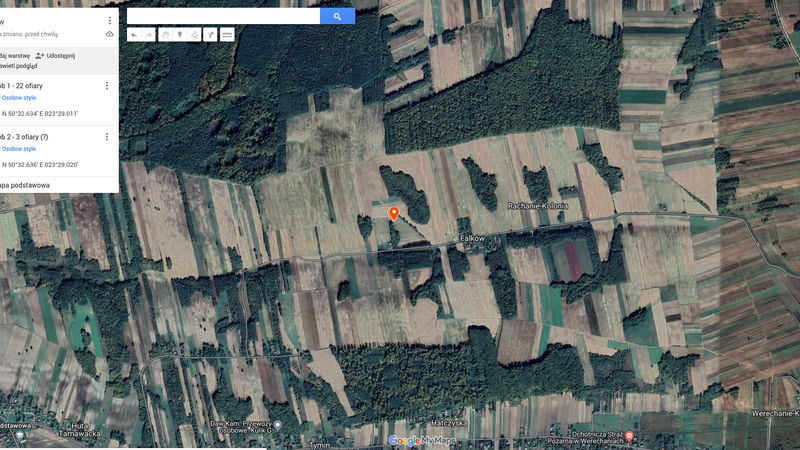 Falków fotografia satelitarna 1a
Falków fotografia satelitarna 1a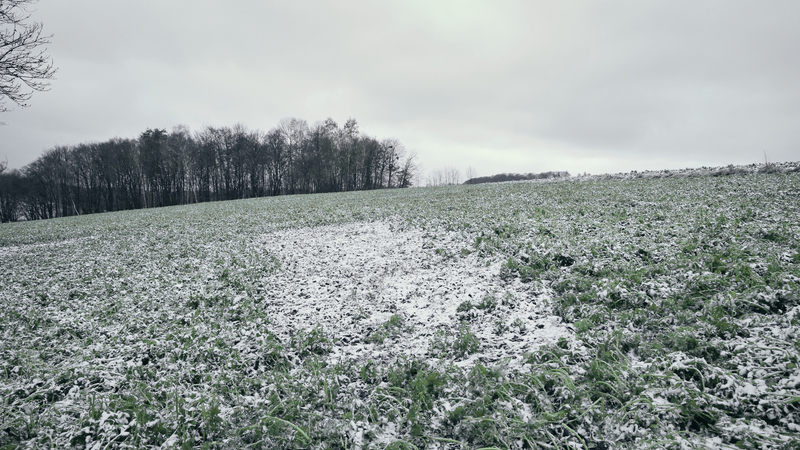 Falków fotografia 1 lokalizacji 1
Falków fotografia 1 lokalizacji 1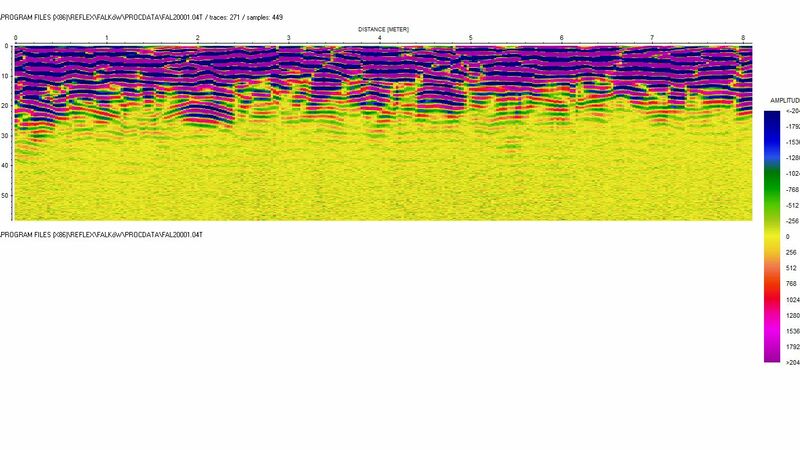 Falków FAL20001
Falków FAL20001Transkrypcje
Contact and cooperation
We are still looking for information on the identity of the victims and the location of Jewish graves in Falków. If you know something more, write to us at the following address: fundacjazapomniane@gmail.com.
Bibliography
Recording of the Zapomniane Foundation (audio file), Wiesław K. and Anna, residents of Falków born after the war, keywords: Jewish grave in Falków; exp. Agnieszka Nieradko and Ewa Koper, Falków, September 21st, 2021.
We have collected the materials about this village thanks to the funding provided by the International Holocaust Remembrance Alliance as part of the project “The rural Holocaust. Collecting and safeguarding the never recorded testimonies 100 forgotten Jewish graves 2021-2022” and also thanks to the support of the Embassy of the Federal Republic of Germany in Warsaw.
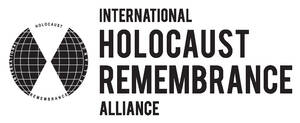
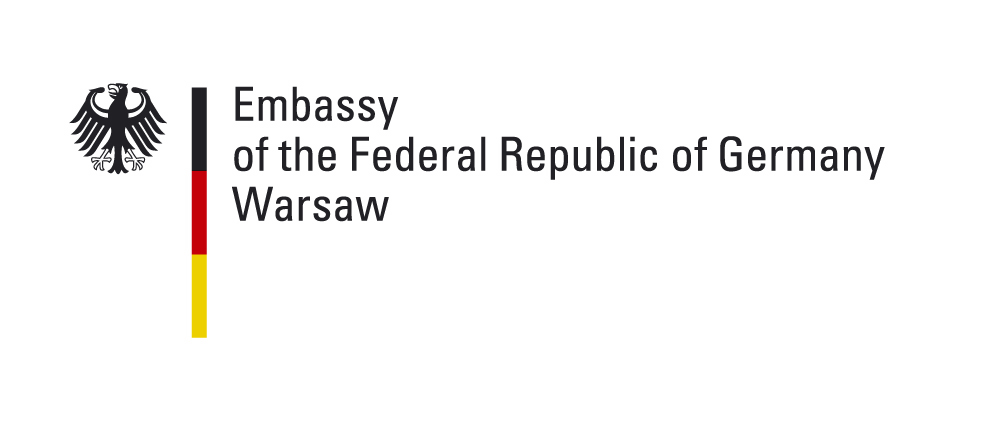
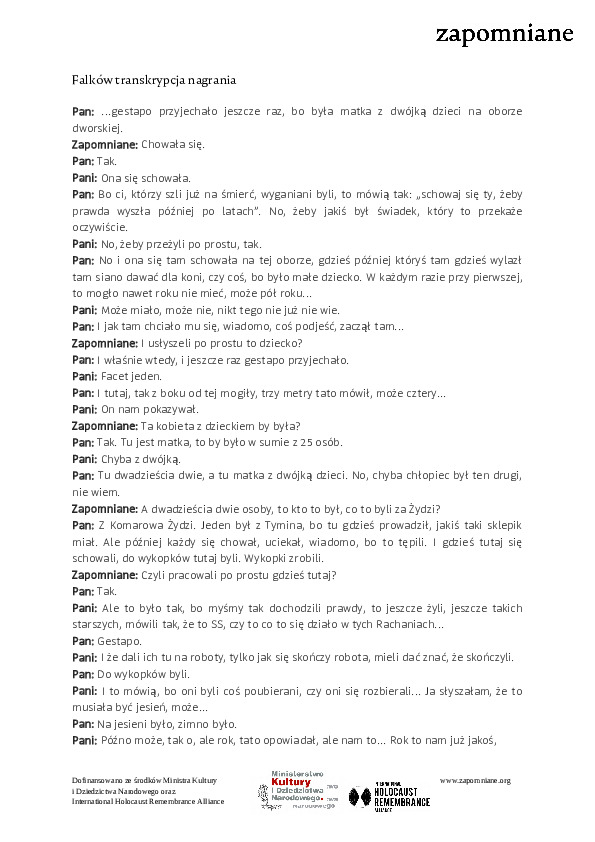 Falków transkrypcja nagrania
Falków transkrypcja nagrania